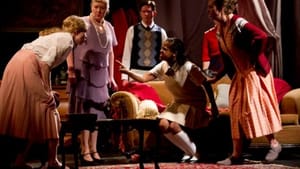Stay in the Loop
BSR publishes on a weekly schedule, with an email newsletter every Wednesday and Thursday morning. There’s no paywall, and subscribing is always free.
A lie that is partially true
EgoPo's 'Children's Hour' by Lillian Hellman

Lillian Hellman’s Children’s Hour was first produced in 1934. What makes it relevant today is not only its theme of forbidden love between two women, but also the decision of one of the main characters to live life on her terms without relying on marriage to provide her place in the world.
EgoPo Classic Theater’s production of The Children’s Hour starts slowly. A sewing lesson at a girls' school in an old farmhouse run by two young women, Karen Wright (Jenna Horton) and Martha Dobie (Emilie Krause), who have invested all they have to make the school work. And then one girl tells a lie that turns out to be a partial truth, and everything falls apart.
Life is not easy for Karen and Martha. They have to contend with Karen’s engagement to Martha’s cousin Dr. Joe Cardin (Keith Conallen), Martha’s jealousy, and the unwelcome presence of Martha’s demanding aunt, Lily Mortar (Mary Lee Bednarek), a failed actress who teaches the girls Shakespeare and generally makes herself a nuisance.
When spoiled student Mary Tilford (Maggie Johnson) can’t get her way, she runs off and whispers to her grandmother, Amelia Tilford (Cheryl Williams), that Karen and Martha are having a lesbian relationship, claiming to have heard them making love at night. Mrs. Tilford calls the other parents, and suddenly the school has no more students. Realizing what has happened, Martha and Karen first confront Mary, who is backed up by another student, Rosalie Wells (Samia Merritt), then choose to sue.
While the first act builds to Mary’s lie, the second deals with the consequences for Karen and Martha and Joe. A failed lawsuit has left the two women penniless and shunned. Karen is not sure she can trust Joe, and Martha, realizing there might have been some truth in the accusations, blames herself for all that has happened. Even Mrs. Tilford’s recognition that Mary has lied can’t put the pieces back together again.
What would Mary tweet?
What was once shocking, the relationship between Martha and Karen, no longer upsets the way it once did, although there are many who still find it unacceptable. In today’s world Martha and Karen would be able to marry, and Mary would be posting whatever hateful thing she wanted to say on social media. And yes, there are truths behind the story that still have relevance.
Words do have the power to wound. Love is not always easy and the right choice. People jump to conclusions because of what they want to believe without gathering all the facts. Children can be cruel, and sometimes adults pay the price. We do not have to share the prejudices of an earlier time to know that today even the hint of impropriety by a teacher is threatening to all.
This production creates a rundown world where young girls giggle and gossip and learn to sew while fantasizing about sex and love and revenge. The set, designed by Markéta Fantová, fills the center of the room with the audience on two sides. Split between a schoolroom and a sitting room, the space allows the characters to move between areas without moving the scenery around, while the stage at the end becomes a living room where the most dramatic action takes place.
Uneven cast
A large cast means that for once actors need only play one role each, but it also means that there is an unevenness in those performances. Horton makes us feel for Karen’s dilemma. She portrays an inner strength that allows her to make hard choices, while Krause’s Martha is credibly weaker, so much so that sometimes she seems to be talking to herself rather than the audience. Williams goes from unyielding matriarch to guilt-driven persecutor with grace, and Bednarek is appropriately over-the-top as an actress who can’t stop acting. Conallen, as almost the lone male in the show, creates a reassuring male presence — he is not the bad guy here, but rather a nice one who’s a bit oblivious to quite what’s going on.
The schoolgirls, however, seem a bit too old to be these schoolgirls. College graduates, they’re not quite able to become believably younger. And while Johnson as Mary pouts, she’s a bit too obvious as the villain of the piece — and, being a bit taller than the others, stands out as trouble from the moment she appears. Might a more subtle performance have been more devastating?
But the play still holds an emotional charge. To focus only on the same-sex relationship would diminish the power of the play, which is about so much more. When Karen realizes that she has to start all over again, we feel for what she has gone through and what she has to face ahead of her. That she will have the resources to do so is some comfort, but we wonder what we might do in that position, if we would have the strength to go on.
What, When, Where
The Children’s Hour. By Lillian Hellman. Adrienne Mackey directed. Through October 25, 2015 presented by EgoPo Classic Theater at the Latvian Society, 531 N. 7th Street, Philadelphia. 267-273-1414 or egopo.org.
Sign up for our newsletter
All of the week's new articles, all in one place. Sign up for the free weekly BSR newsletters, and don't miss a conversation.

 Naomi Orwin
Naomi Orwin